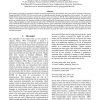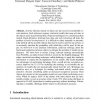10 search results - page 2 / 2 » Automatically Identifying the Source Words of Lexical Blends... |
ACL
2004
13 years 6 months ago
2004
Supervised learning methods for WSD yield better performance than unsupervised methods. Yet the availability of clean training data for the former is still a severe challenge. In ...
ACL
2008
13 years 6 months ago
2008
We present a novel framework for the discovery and representation of general semantic relationships that hold between lexical items. We propose that each such relationship can be ...
LREC
2010
13 years 6 months ago
2010
In this paper we describe two geometrical models of meaning representation, the Semantic Atlas (SA) and the Automatic Contexonym Organizing Model (ACOM). The SA provides maps of m...
COLING
2002
13 years 5 months ago
2002
In this paper we investigate the task of automatically identifying the correct argument structure for a set of verbs. The argument structure of a verb allows us to predict the rel...
PERVASIVE
2006
Springer
13 years 5 months ago
2006
Springer
Abstract. Activity inference based on object use has received considerable recent attention. Such inference requires statistical models that map activities to the objects used in p...


